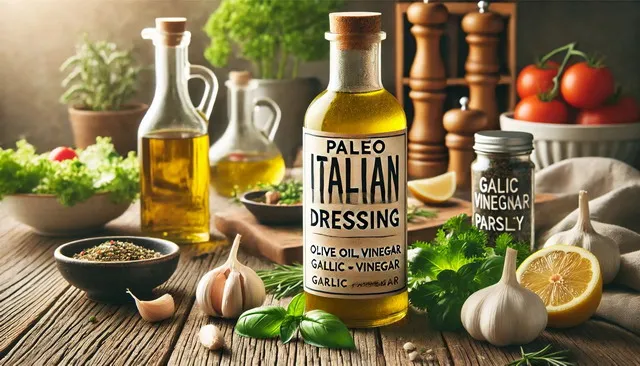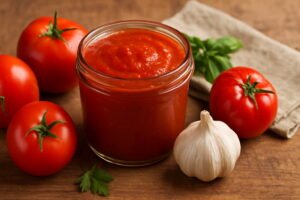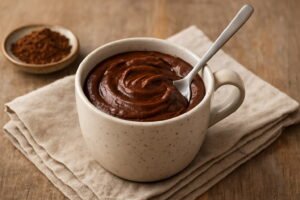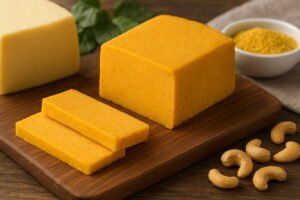No meal is complete without a great dressing, and a Paleo Italian dressing can elevate dishes while adhering to the guidelines of the diet. This recipe combines wholesome ingredients that are both delicious and healthy, creating a flavorful addition to salads, meats, and vegetables. Crafting this dressing is not only simple but also rewarding, allowing individuals to enjoy a taste of Italy while staying true to their nutritional goals.
In the following sections, the article will provide insights into ingredient selection and the emulsification process for the perfect blend. Readers will discover variations and alternatives to suit their taste preferences, ensuring this dressing fits seamlessly into any meal plan. By incorporating this Paleo Italian dressing into their meals, individuals can enhance flavor without compromising health.
Key Takeaways
- The recipe offers a balance of flavors using healthy, clean ingredients.
- It provides ideas for variations to suit different dietary needs.
- Homemade dressings are a healthier alternative to store-bought options.
Understanding the Paleo Diet Guidelines
The Paleo diet emphasizes the consumption of whole, unprocessed foods while avoiding modern agricultural products. A clear understanding of its principles can help those looking to create meal options, including recipes like Paleo-Friendly Italian Dressing.
Importance of Whole Foods
Whole foods are the cornerstone of the Paleo diet. This includes fruits, vegetables, nuts, seeds, and lean meats. These foods provide essential nutrients and are minimally processed, aligning with the diet’s emphasis on natural ingredients.
Eating whole foods can lead to better digestion and improved overall health. Additionally, these foods are generally free from additives, preservatives, and artificial ingredients, making them a healthier option. People preparing meals like a Whole30 Paleo Italian Dressing can rely on fresh herbs, quality oils, and vinegar as their base for flavor and nutrition.
Prohibited Ingredients in Paleo Diet
Certain ingredients are strictly avoided in the Paleo diet. These include grains, dairy, legumes, processed sugars, and artificial additives. Grains like wheat and rice, for instance, can disrupt digestion and inflammation in some individuals.
Additionally, dairy products can cause issues for those who are lactose intolerant. Processed sugars and additives are considered harmful due to their link with various health issues. When crafting a Paleo Italian dressing, it is crucial to exclude items like conventional vinegar made from grains, opting instead for varieties that comply with Paleo principles.
Choosing the Right Ingredients
Selecting high-quality ingredients is crucial for making a flavorful Paleo Italian dressing. The focus should be on freshness, quality, and natural elements. Each component contributes to the overall taste and healthiness of the dressing.
Selecting Quality Olive Oil
Choosing the right olive oil enhances the flavor profile of a Paleo Italian dressing. Opt for extra virgin olive oil (EVOO) for its rich taste and health benefits.
Consider the following when selecting olive oil:
- Origin: Look for oils labeled as originating from regions like Italy or Spain for authentic flavors.
- Cold-Pressed: This method retains more nutrients and improves taste.
- Freshness: Check the harvest date to ensure you’re using a fresh product.
Incorporate a robust olive oil to give the dressing a rich backbone. It pairs well with the tanginess of vinegar and the sharpness of garlic.
Opting for Natural Vinegars
Using high-quality vinegar can elevate the dressing’s acidity and complexity. Balsamic vinegar and red wine vinegar are popular choices in Italian dressings.
Key factors to consider include:
- Organic Options: Choose organic vinegars to avoid synthetic additives and ensure purity.
- Flavor Profile: Vary the vinegar based on the desired taste; balsamic adds sweetness, while red wine offers sharpness.
- Unfiltered Variants: These tend to have more depth and character, enhancing the dressing’s overall flavor.
Integrating natural vinegar balances the richness of olive oil, creating a harmonious blend for the dressing.
Selecting Fresh Herbs and Garlic
Fresh herbs and garlic bring brightness to the dressing. Popular choices include basil, oregano, and parsley.
When selecting herbs and garlic, keep in mind:
- Freshness: Look for vibrant colors and strong aromas to ensure potency.
- Local Sourcing: Local markets may offer fresher options than grocery stores.
- Quality over Quantity: A smaller amount of high-quality herbs can often outshine larger quantities of mediocre ones.
Incorporating fresh herbs and garlic not only boosts flavor but also adds nutritional benefits, making the dressing healthier.
Creating a Flavor Profile
Balancing flavors is essential for crafting a delicious Paleo Italian dressing. Key components include the right acids, a touch of sweetness without sugar, and an array of herbs and spices that enhance the overall taste.
The Role of Acids
Acids are crucial in any salad dressing, particularly in a Paleo Italian style. Lemon juice serves as an ideal acid, adding brightness and a zesty kick. The acidity complements the richness of olive oil while cutting through heaviness, making each bite feel lighter and fresher.
Vinegar can also be incorporated, but it’s essential to choose varieties that align with the Paleo diet, such as apple cider vinegar. A balanced acid level ensures the dressing enhances the flavors of salads without overwhelming them.
Balancing Sweetness without Sugar
In a sugar-free Paleo Italian dressing, alternative sources for sweetness are vital. Consider using whole food ingredients like dates or maple syrup in moderation. These provide natural sweetness while adhering to Paleo principles.
Adding a small amount of honey can also serve this purpose. When incorporated, the sweet element helps to balance the acidity from lemon juice, creating a pleasant harmony in the flavor profile. This balance is key to ensuring that the dressing complements various salads and vegetables.
Incorporating Herbs and Spices
Fresh herbs and spices contribute depth and complexity to the dressing. Common additions include basil, oregano, and parsley, which highlight typical Italian flavors. Using fresh herbs enhances the vibrant taste and adds an aromatic quality that dried alternatives may lack.
Incorporate garlic for an additional layer of flavor, providing a savory undertone. A pinch of black pepper and red pepper flakes can enhance the dressing without overpowering it. Flavor precision is essential in achieving a well-rounded dressing.
The Process of Emulsification
Emulsification is a crucial technique in creating a stable Paleo Italian dressing. This process involves combining oil and vinegar, which normally do not mix. Mastering the methods of whisking and achieving the right consistency ensures a smooth and flavorful vinaigrette.
Whisking Techniques
Whisking is essential for creating emulsions. For a successful Paleo Italian vinaigrette, it’s important to use a good-quality whisk or an immersion blender.
- Combine Ingredients: Start by mixing the vinegar, mustard, and any seasonings in a bowl.
- Add Oil Slowly: Gradually pour in the oil while whisking rapidly. This step allows the oil to slowly incorporate into the vinegar.
- Mix Consistently: Continue whisking until the mixture thickens and becomes uniform.
A consistent motion and the right speed enhance the emulsification process. If using an immersion blender, blend ingredients at the bottom of the container and slowly move up as the oil is added.
Achieving the Perfect Consistency
The ideal consistency for a dressing should be creamy yet pourable.
- Visual Check: The vinaigrette should coat the back of a spoon.
- Adjusting Texture: If it’s too thick, add a teaspoon of water or more vinegar; if too thin, whisk in more oil.
- Flavor Balancing: Taste and adjust seasonings after emulsification. Fresh herbs, garlic, or nutritional yeast can elevate flavor without compromising the Paleo aspect.
Monitoring these factors during emulsification leads to a dressing that complements salads perfectly. A stable emulsion provides a consistent taste experience, ensuring that every bite is enjoyable.
Variations and Alternatives
Exploring variations and alternatives for the Paleo Italian dressing allows for adaptability to personal preferences and dietary needs. Different ingredients can enhance flavor and accommodate specific diets like gluten-free or dairy-free.
Italian Dressing with Apple Cider Vinegar
Using apple cider vinegar in a Paleo Italian dressing provides a tangy flavor while offering health benefits. It may aid digestion and promote gut health.
To create this dressing, combine:
- 1/2 cup olive oil
- 1/4 cup apple cider vinegar
- 1 tablespoon Dijon mustard
- 1 teaspoon garlic powder
- 1 teaspoon dried oregano
- Salt and pepper to taste
Mix all ingredients in a jar and shake well before serving. This version is gluten-free and dairy-free, making it suitable for various dietary restrictions.
Creamy Italian Dressing Variations
For those preferring a creamy texture in their dressing, alternatives can incorporate avocados or cashews, aligning with Paleo guidelines.
A creamy Italian dressing might include:
- 1/2 cup avocado or soaked cashews
- 1/4 cup olive oil
- 3 tablespoons apple cider vinegar
- 1 tablespoon lemon juice
- 1 teaspoon garlic powder
- 2 teaspoons Italian seasoning
Blend until smooth, adding water as needed for consistency. This variation not only provides creaminess but also keeps the dressing dairy-free and suitable for a Paleo lifestyle.
Adapting the Recipe for Different Uses
The Paleo Italian Dressing can be versatile, making it suitable for various culinary applications. Adjusting the ingredients can enhance its use for salads or as a marinade.
Salad Dressings
The Paleo Italian Dressing is excellent for enhancing salads. It pairs well with mixed greens, cucumber, and cherry tomatoes. The bold flavor profile, featuring olive oil, vinegar, and herbs, complements fresh vegetables.
To prepare a classic salad, use:
- 1/4 cup olive oil
- 2 tablespoons red wine vinegar
- 1 teaspoon Italian herbs
- Salt and pepper to taste
Drizzle the dressing over the salad immediately before serving for a crisp experience. For added zest, consider incorporating lemon juice or minced garlic. This dressing not only provides flavor but also maintains a healthy profile, aligning well with Paleo guidelines.
Marinades for Proteins and Vegetables
This dressing can also serve as a marinade, making it ideal for chicken and vegetables. When marinating chicken, the acidity of the vinegar helps tenderize the meat while infusing flavor.
A simple marinade blend might include:
- 1/2 cup Paleo Italian Dressing
- 1 pound of chicken breast or thighs
Let the chicken marinate for at least 30 minutes. For vegetables, toss them in the dressing and let them sit for a similar duration. This method enhances the taste and prepares them for grilling or roasting. Using the dressing as a marinade highlights its versatility while keeping meals compliant with a Paleo diet.
Tips for Making Dressing in Advance
Preparing dressing in advance can save time and enhance meal flavor. Knowing how to store and maintain freshness is key to enjoying a delicious Homemade Paleo Italian Vinaigrette.
Storage Recommendations
For best results, store homemade dressing in a clean, airtight container. Glass jars are excellent choices. They prevent oxidation and help maintain flavor and texture.
Place the dressing in the refrigerator immediately after making it. It can last up to one week if stored properly.
Labeling the container with the date will help track freshness. For easy use, consider portioning the dressing into smaller containers.
If using olive oil, be aware that it may solidify in the fridge. Simply warm the dressing slightly before use to return it to liquid form.
Maintaining Freshness
To keep the dressing fresh, avoid introducing contamination from utensils. Always use a clean spoon when serving. This prevents bacteria from spoiling the dressing.
Emulsification is essential; shake or stir the dressing before each use to mix the ingredients well.
For added longevity, consider adding fresh herbs only to portions that will be consumed immediately. This keeps the rest of the dressing vibrant and flavorful.
If the dressing develops a separation layer, it’s normal. Simply shake to recombine. Regularly check for signs of spoilage, such as off smells or unusual color changes, to ensure quality.
Health Benefits of Homemade Dressings
Homemade dressings offer distinct health advantages, particularly when using fresh ingredients in recipes like Paleo Italian Dressing. They provide a means to control nutritional content and avoid harmful additives often found in store-bought versions.
Nutritional Advantages
Homemade dressings allow for significant customization. Using ingredients such as high-quality oils, fresh herbs, and vinegar can maximize health benefits.
- Fresh Ingredients: These often retain more nutrients compared to pre-packaged options.
- Healthy Fats: Oils like olive oil are rich in heart-healthy monounsaturated fats.
- Flavor Boost: Fresh herbs can elevate dishes without the need for excessive salt or sugar.
For those following a low-carb regimen, a Paleo Italian Dressing Recipe can enhance salads or vegetables without added sugars or unnecessary carbs. This makes it an excellent choice for maintaining a healthy diet while enjoying flavorful meals.
Avoiding Unwanted Additives
Store-bought dressings may contain preservatives, artificial flavors, and sugars. Homemade versions allow for complete ingredient transparency.
- No Preservatives: Eliminating unwanted chemicals promotes better health.
- Controlled Sugar Levels: Homemade dressings can be naturally sweetened or left unsweetened, supporting low-carb lifestyles.
By crafting a Paleo Italian Dressing at home, individuals can avoid the hidden ingredients that could disrupt dietary goals. This level of customization leads to healthier meal options without sacrificing flavor.
Navigating Common Challenges
When preparing a Paleo Italian dressing, it’s important to identify common issues that may arise, such as a broken emulsion or unbalanced flavors. Addressing these concerns can enhance the overall quality of the dressing and its compatibility with various dishes.
Fixing a Broken Emulsion
A broken emulsion occurs when the oil and vinegar separate, resulting in a salad dressing that lacks cohesion. This often happens due to the rapid introduction of oil or insufficient emulsifying agents. To fix it, start by whisking a small amount of the separated dressing in a bowl. Gradually add more oil while whisking continuously.
If the dressing remains unstable, consider adding an emulsifier like Dijon mustard or egg yolk. For a simpler approach, blending the ingredients in a food processor can also create a more stable emulsion. This technique is effective in producing the Best Paleo Italian Dressing Recipe, ensuring a smooth consistency.
Adjusting Flavors
Adjusting flavors in a Paleo Italian dressing is key to achieving the desired taste. A simple recipe might tip too acidic or bland, leading to a disappointing result. To balance acidity, vinegar can be reduced while adding a touch of maple syrup or honey for sweetness.
Consider an appropriate blend of herbs. Adding dried oregano or fresh basil can enhance the dressing’s authenticity and flavor profile. Taste the dressing after each adjustment, aiming for harmony. A well-balanced dressing not only complements salads but also elevates grilled vegetables and meats, making it versatile for various dishes.
Pairing with Paleo-Friendly Dishes
Paleo Italian dressing enhances a variety of dishes while adhering to a clean eating lifestyle. It adds flavor to salads and main courses, making meals more exciting and satisfying. Here are some ways to pair this dressing effectively.
Complementing Salads
The versatility of Paleo Italian dressing makes it an excellent choice for salads. It pairs well with mixed greens, arugula, or spinach, providing a zesty flavor that elevates fresh vegetables. Adding components like cherry tomatoes, cucumbers, bell peppers, and olives creates a vibrant and colorful dish.
For a heartier option, consider adding grilled chicken or shrimp. This can turn a simple salad into a balanced meal. Using this dressing without sugar or dairy aligns with Paleo guidelines and keeps the dish wholesome. Nutritional yeast can also be added for added flavor, making it suitable for those on a keto diet who prioritize low-carb options.
Enhancing Main Courses
Paleo Italian dressing serves as a flavorful addition to various main dishes. It works especially well as a marinade for proteins like chicken, steak, or fish. The acidity and herbs in the dressing tenderize the meat, infusing it with rich flavor while keeping the dish compliant with Paleo standards.
Drizzling it over roasted vegetables also adds depth and a tangy twist. Combining it with sautéed zucchini or cauliflower rice engages the palate. When preparing meals for a keto diet, this dressing adds taste without the excess carbohydrates, making it a smart choice for anyone seeking balanced nutrition without sacrificing flavor.



